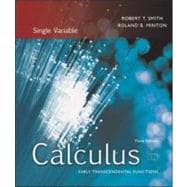
Calculus, Single Variable: Early Transcendental Functions
by Smith, Robert T; Minton , Roland-

This Item Qualifies for Free Shipping!*
*Excludes marketplace orders.
Rent Textbook
New Textbook
We're Sorry
Sold Out
Used Textbook
We're Sorry
Sold Out
eTextbook
We're Sorry
Not Available
How Marketplace Works:
- This item is offered by an independent seller and not shipped from our warehouse
- Item details like edition and cover design may differ from our description; see seller's comments before ordering.
- Sellers much confirm and ship within two business days; otherwise, the order will be cancelled and refunded.
- Marketplace purchases cannot be returned to eCampus.com. Contact the seller directly for inquiries; if no response within two days, contact customer service.
- Additional shipping costs apply to Marketplace purchases. Review shipping costs at checkout.
Summary
Table of Contents
| Preliminaries | |
| Polynomials and Rational Functions | |
| Graphing Calculators and Computer Algebra Systems | |
| Inverse Functions | |
| Trigonometric and Inverse Trigonometric Functions | |
| Exponential and Logarithmic Functions Hyperbolic Functions Fitting a Curve to Data | |
| Transformations of Functions | |
| Limits and Continuity | |
| A Brief Preview of Calculus: Tangent Lines and the Length of a Curve | |
| The Concept of Limit | |
| Computation of Limits | |
| Continuity and its Consequences The Method of Bisections | |
| Limits Involving Infinity Asymptotes | |
| Formal Definition of the Limit Exploring the Definition of Limit Graphically | |
| Limits and Loss-of-Significance Errors Computer Representation of Real Numbers | |
| Differentiation | |
| Tangent Lines and Velocity | |
| The Derivative Numerical Differentiation | |
| Computation of Derivatives: The Power Rule Higher Order Derivatives Acceleration | |
| The Product and Quotient Rules | |
| The Chain Rule | |
| Derivatives of the Trigonometric Functions | |
| Derivatives of the Exponential and Logarithmic Functions | |
| Implicit Differentiation and Inverse Trigonometric Functions | |
| The Mean Value Theorem | |
| Applications of Differentiation | |
| Linear Approximations and Newton’s Method | |
| Indeterminate Forms and L’Hopital’s Rule | |
| Maximum and Minimum Values | |
| Increasing and Decreasing Functions | |
| Concavity and the Second Derivative Test | |
| Overview of Curve Sketching | |
| Optimization | |
| Related Rates | |
| Rates of Change in Economics and the Sciences | |
| Integration | |
| Antiderivatives | |
| Sums and Sigma Notation Principle of Mathematical Induction | |
| Area | |
| The Definite Integral Average Value of a Function | |
| The Fundamental Theorem of Calculus | |
| Integration by Substitution | |
| Numerical Integration Error Bounds for Numerical Integration | |
| The Natural Logarithm as an Integral The Exponential Function as the Inverse of the Natural Logarithm | |
| Applications of the Definite Integral | |
| Area Between Curves | |
| Volume: Slicing, Disks, and Washers | |
| Volumes by Cylindrical Shells | |
| Arc Length and Surface Area | |
| Projectile Motion | |
| Applications of Integration to Physics and Engineering | |
| Probability | |
| Integration Techniques | |
| Review of Formulas and Techniques | |
| Integration by Parts | |
| Trigonometric Techniques of Integration Integrals Involving Powers of Trigonometric Functions Trigonometric Substitution | |
| Integration of Rational Functions Using Partial Fractions Brief Summary of Integration Techniques | |
| Integration Tables and Computer Algebra Systems | |
| Improper Integrals A Comparison Test | |
| First-Order Differential Equations | |
| Growth and Decay Problems Compound Interest Modeling with Differential Equations | |
| Separable Differential Equations Logistic Growth | |
| Direction Fields and Euler's Method | |
| Systems of First-Order Differential Equations Predator-Prey Systems | |
| Infinite Series | |
| Sequences of Real Numbers | |
| Infinite Series | |
| The Integral Test and Comparison Tests | |
| Alternating Series Estimating the Sum of an Alternating Series | |
| Absolute Convergence and the Ratio Test The Root Test Summary of Convergence Tests | |
| Power Series | |
| Taylor Series Representations of Functions as Series Proof of Taylor’s Theorem | |
| Applications of Taylor Series The Binomial Series | |
| Fourier Series Parametric Equations and Polar Coordinates | |
| Plane Curves and Parametric Equations | |
| Calculus and Parametric Equations | |
| Arc Length and Surface Area in Parametric Equations | |
| Polar Coordinates | |
| Calculus and Polar Coordinates | |
| Conic Sections | |
| Conic Sections in Polar Coordinates | |
| Vectors and the Geometry of Space | |
| Vectors in the Plane | |
| Vectors in Space | |
| The Dot Product Components and Projections | |
| The Cross Product | |
| Lines and Planes in Space | |
| Surfaces in Space | |
| Table of Contents provided by Publisher. All Rights Reserved. |
An electronic version of this book is available through VitalSource.
This book is viewable on PC, Mac, iPhone, iPad, iPod Touch, and most smartphones.
By purchasing, you will be able to view this book online, as well as download it, for the chosen number of days.
Digital License
You are licensing a digital product for a set duration. Durations are set forth in the product description, with "Lifetime" typically meaning five (5) years of online access and permanent download to a supported device. All licenses are non-transferable.
More details can be found here.
A downloadable version of this book is available through the eCampus Reader or compatible Adobe readers.
Applications are available on iOS, Android, PC, Mac, and Windows Mobile platforms.
Please view the compatibility matrix prior to purchase.